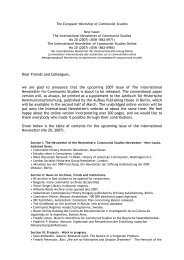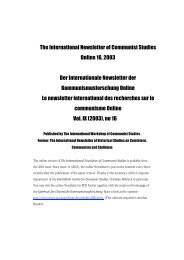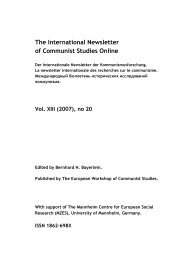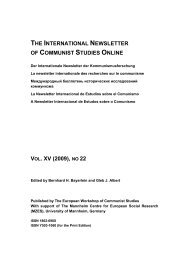VOL. XVI (2010), NO 23 - The International Newsletter of Communist ...
VOL. XVI (2010), NO 23 - The International Newsletter of Communist ...
VOL. XVI (2010), NO 23 - The International Newsletter of Communist ...
Erfolgreiche ePaper selbst erstellen
Machen Sie aus Ihren PDF Publikationen ein blätterbares Flipbook mit unserer einzigartigen Google optimierten e-Paper Software.
<strong>The</strong> <strong>International</strong> <strong>Newsletter</strong> <strong>of</strong> <strong>Communist</strong> Studies Online <strong>XVI</strong> (<strong>2010</strong>), no. <strong>23</strong> 18<br />
(Comintern), 7 or through the interaction between Western <strong>Communist</strong> parties among each<br />
other. 8 Yet the question <strong>of</strong> the Comintern as an actor as well as a symbol not only throughout<br />
the world, but within its host country, Soviet Russia, has not yet received a re-examination<br />
under the conditions <strong>of</strong> the “archival revolution” – just as the question <strong>of</strong> the impact <strong>of</strong> the<br />
<strong>Communist</strong> movement as an international and internationalist one on practices and<br />
perceptions in Soviet society has remained an open one. 9 This gap is truly remarkable, since<br />
the role <strong>of</strong> Soviet Russia as a “golden calf” and point <strong>of</strong> reference within the <strong>Communist</strong><br />
movement is thoroughly analysed, 10 but not so much the role <strong>of</strong> the Soviet <strong>Communist</strong><br />
movement as an actor within the international <strong>Communist</strong> context.<br />
In the years after the October revolution, internationalism was omnipresent not only in the<br />
leaders’ minds, but also in Soviet public practices. 11 Uprisings, strikes and revolutions<br />
throughout the whole world occupied the front pages <strong>of</strong> state and party newspapers, 12 and<br />
were in the most prominent cases accompanied by large-scale campaigns. Schools, streets,<br />
factories, whole districts were named after foreign revolutionary leaders alive (e.g. Max<br />
Hoelz, André Marty, Clara Zetkin) or dead (most prominently Rosa Luxemburg and Karl<br />
Liebknecht). An international socialist heritage <strong>of</strong> the past (Marx and Engels, the Paris<br />
Commune) obtained a solid place in the new festivity calendar and through it in public space<br />
and perception; the “<strong>International</strong>e”, old workers’ movement hymn and anthem <strong>of</strong> the new<br />
revolutionary state until 1943, was not only played on the Kremlin’s tower clock, but sung on<br />
every <strong>of</strong>ficial or semi-<strong>of</strong>ficial occasion. 13 <strong>The</strong> <strong>Communist</strong> <strong>International</strong> was omnipresent as<br />
well, not only through its pompously performed “World Congresses”, but through slogans and<br />
inscriptions in everyday context. 14 Last not least, the Soviet leaders, many <strong>of</strong> them just<br />
having returned from years <strong>of</strong> exile, could be perceived as personifications <strong>of</strong> the<br />
7 Bernhard H. Bayerlein: Das neue Babylon. Strukturen und Netzwerke der Kommunistischen <strong>International</strong>e und<br />
ihre Klassifizierung. // Jahrbuch für Historische Kommunismusforschung (2004), pp. 181-270; Pierre Broué: Histoire<br />
de l'<strong>International</strong>e <strong>Communist</strong>e. 1919-1943, Paris, Fayard, 1997; Kevin McDermott, Jeremy Agnew: <strong>The</strong> Comintern.<br />
A History <strong>of</strong> the Comintern from Lenin to Stalin. 1919-1943, Basingstoke-London, Macmillan, 1996.<br />
8 Joachim Schröder: <strong>International</strong>ismus nach dem Krieg. Die Beziehung zwischen deutschen und französischen<br />
Kommunisten 1918-19<strong>23</strong>, Essen, Klartext, 2007. Studies on internationalism as a control instrument <strong>of</strong> Soviet<br />
foreign policy are not directly relevant for this context, however for further reading on this subject, see: Jonathan C.<br />
Valdez: <strong>International</strong>ism and the Ideology <strong>of</strong> Soviet Influence in Eastern Europe, Cambridge e.a., Cambridge<br />
University Press, 2009²; Jan Foitzik: Der proletarische <strong>International</strong>ismus des sozialistischen Weltsystems. Die<br />
Mythologisierung des sowjetischen Führungsanspruchs. // vorgänge. Zeitschrift für Bürgerrechte und<br />
Gesellschaftspolitik 46 (2007), 1, pp. 115-124.<br />
9 At least since the rather one-sided elaborations on this subject by Soviet historiography. See a.o. Leonid I.<br />
Iakovlev: Internatsional'naia solidarnost' trudiashchikhsia zarubezhnykh stran s narodami Sovetskoi Rossii. 1917-<br />
1922, Moskva, Nauka, 1964; Iurii A. L'vunin: Bor'ba Kommunisticheskoi partii za ukreplenie internatsional'nykh<br />
sviazei rabochego klassa SSSR. 1924-1928 gg., Moskva, Izdatel'stvo Moskovskogo universiteta, 1975; and various<br />
others.<br />
10 Jerzy Holzer: Das einzige Vaterland des Proletariers – die Sowjetunion. Ob gut oder schlecht, sie ist mein Land!<br />
// Jahrbuch für historische Kommunismusforschung (2008), pp. 24-31; Geyer, Sowjetrussland, p.3.<br />
11 First impressions <strong>of</strong> this omnipresence are best found in diaries and memoirs <strong>of</strong> political figures who were not<br />
unconditionally on the side <strong>of</strong> the Bolsheviks but were „left enough” to take notice <strong>of</strong> such phenomena, e.g.:<br />
Alexander Berkman: <strong>The</strong> Bolshevik Myth. Diary 1920-22, New York, Boni & Liveright, 1925; Fedor I. Dan: Dva goda<br />
skitanii. 1919-1921, Berlin, Hermann, 1922; Vatslav Solskii: 1917 god v Zapadnoi oblasti i na Zapadnom fronte,<br />
Minsk, Tesei, 2004. First archival explorations by the author only have confirmed this impression.<br />
12 Just as an example, the title page <strong>of</strong> Rabochii put’ (Smolensk) from December 7, 1920, carries following<br />
headlines: <strong>The</strong> Red Front / <strong>The</strong> End <strong>of</strong> Balakhovich / For the Third <strong>International</strong> / Demands <strong>of</strong> the English Railroad<br />
Workers / Victory on the Labour Front / On the Dawn <strong>of</strong> Trade Relations with the West / Workers from America /<br />
Telephones in the Village (Russian State Archive <strong>of</strong> Social and Political History [RGASPI], f. 17 op. 60 d. 12 l. 85).<br />
Of eight headlines, four are related to foreign matters, <strong>of</strong> which three directly refer to the international <strong>Communist</strong><br />
movement.<br />
13 Nadezhda A. Soboleva: Ocherki istorii rossiiskoi simvoliki. Ot tamgi do simbolov gosudarstvennogo suvereniteta,<br />
Moskva, Znak, 2006, p. 404; Orlando Figes, Boris I. Kolonitskii: Interpreting the Russian Revolution. <strong>The</strong> Language<br />
and Symbols <strong>of</strong> 1917, New Haven, Yale University Press, 1999, p. 63ff.<br />
14 Amongst other places, the Comintern <strong>of</strong>ten got mentioned on Red Army flags. For Isaac Babel, the typical Red<br />
Army flag <strong>of</strong> 1920 featured a star and “some inscription about the 3 rd <strong>International</strong>” (Isaak Babel: Die Reiterarmee.<br />
Aus dem Russischen übersetzt, herausgegeben und kommentiert von Peter Urban, Berlin, Friedenauer Presse,<br />
1994, p. 62); for an example <strong>of</strong> such a flag design, see Soboleva, Ocherki istorii rossiiskoi simvoliki, p. [224].














